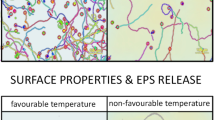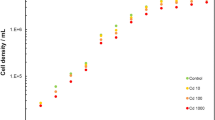Summary
The paper describes the adhesion of algal spores to glass surfaces with different degrees of roughness (surface tension, contact angle and adsorption capacity were taken as indices of roughness). It was observed that spores of various species and different types can be devided into two classes based on the manner in which they attach themselves to glass surfaces: the first type prefers smooth surfaces, and the second type prefers rough surfaces. Changes in the attaching property of the cell are associated with zygote formation — e.g. gametes of Acetabularia belong to the first type and mature zygotes to the second one. In green, brown and red algae both reaction types are observed in mobile and immobile cells. The adhesion process is temperature independent between 13 and 23°C. An influence of surface active compounds on the attachment process was observed; it was found that for example a Silicon film on the glass surface cancels differences in the attaching properties.
The observations are believed to give some information on the surface properties of free-living unicellular stages of algae. These are discussed in connection with structural changes in the reacting surfaces during the pairing process and in connection with the first step in the settlement of epiphytic algae and the production of underwater fouling.
Zusammenfassung
Es wird die Adhäsion von Algensporen an Glasoberflächen unterschiedlicher Rauhigkeit beschrieben; als Kriterien des Rauhheitsgrades werden Oberflächenspannung, Randwinkel und Adsorptionskapazität benutzt. Algensporen verschiedener Arten und Entwicklung heften sich an Glasoberflächen in zwei verschiedenen Typen an: der eine Typus bevorzugt glatte Oberflächen, der andere heftet sich vorzugsweise an rauhen Oberflächen an. Änderungen im Anheftungsverhalten sind mit der Zygotenbildung verbunden. Während die Gameten von Acetabularia zum ersten Anheftungstypus gehören, gehen die reifenden Zygoten zum zweiten Typus der Anheftung über. Innerhalb der Grün-, Braun- und Rotalgen werden die beiden Verhaltenstypen sowohl bei beweglichen, als auch bei unbeweglichen Stadien beobachtet. Der Adhäsionsvorgang ist zwischen 13 und 23°C temperaturunabhängig. Es wurde ein Einfluß von oberflächenspannungsändernden Substanzen auf den Anheftungsprozeß beobachtet; so ebnet z.B. ein Silicon-Film auf den Glasoberflächen die Unterschiede im Anheftungsverhalten ein.
Es wird angenommen, daß die Beobachtungen gewisse Einsichten in die Oberflächeneigenschaften der einzelligen freilebenden Stadien bei Algen gestatten. Diese werden im Zusammenhang mit Strukturänderungen der reagierenden Oberflächen beim Paarungsprozeß diskutiert. Schließlich dürfte auch der erste Schritt bei der Anheftung epiphytischer Algen und die Entstehung von Unterwasser-Foulings durch Adhäsionseigenschaften der in Kontakt tretenden Flächen bestimmt sein.
Similar content being viewed by others
Literatur
Ambrose, E. J.: Cell contacts. Rec. Progr. Surface Sci. 1, 338–359 (1964).
Barnes, H., and H. T. Powell: Some observations on the effect of fibrous surfaces on the settlement of certain sedentary marine organism. J. mar. Biol. Ass. U. K. 29, 723–760 (1950).
Beale, G. H.: The genetic control of cell surfaces. Rec. Progr. Surface Sci. 2, 261–351 (1964).
Beth, K., u. H. F. Linskens: Physiologie des Epiphytismus. Naturw. Rundsch. 17, 254–257 (1964).
Brandt, A. v.: Widerstandsfähigkeit von “Perlon”-Tauwerk gegen Bewuchs. Arch. Fischereiwiss. 11, 60–69 (1960).
Coleman, A. W.: Sexuality. In: R. A. Lewin, Physiology and biochemistry of algae, p. 711–729. New York and London: Academic Press 1962.
Curtis, A. S. G.: The mechanism of adhesion of cells to glass. J. Cell. Biol. 20, 199–215 (1964).
Dettre, R. H., and R. E. Johnson jr.: Contact angle measurement on rough surfaces. In: Contact angle, wettability and adhesion. Advanc. chem. Ser. No. 43, 136–144 (1964).
Ferguson-Wood, E. J.: Investigations on underwater foulings. Aust. J. Marine and Freshwater Research 1, 84–91 (1950).
Holland, L.: The properties of glass surfaces. London: Chapman & Hall 1964.
Linskens, H. F.: Quantitative Bestimmung der Benetzbarkeit von Blattoberflächen. Planta (Berl.) 38, 591–600 (1952).
Physiologie der Fortpflanzung und Sexualität. Fortschr. Bot. 17, 792–794 (1955); 18 332–333 (1956); 19, 386–387 (1957); 20, 267–268 (1958).
Oberflächenspannung an marinen Algen. Proc. kon. ned. Akad. Wet. C 66, 205–217 (1963).
Lund, J. W., and J. F. Talling: Botanical limnological methods with special reference to the algae. Bot. Rev. 23, 489–583 (1957).
Monroy, A.: Chemistry and Physiology of Fertilization. New York, Chicago, San Francisco, Toronto, London: Holt, Rinehart and Winston 1965.
Moscona, M. H., and A. A. Moscona: Inhibition of adhesiveness and aggregation of dissociated cells by inhibitors of protein and RNA synthesis. Science 142, 1070–1071 (1963).
Neudert, W., H. Röpke u. J. Reitstötter: Über den Einfluß der Oberflächenbeschaffenheit fester Materialien auf die Ausbildung des Randwinkels an den Grenzflächen fest/flüssig. Kolloid. Z. 125, 35–40 (1951).
Pomerat, C. M., and C. M. Weiss: The influence of texture and composition of surface on the attachment of sedentary marine organisms. Biol. Bull. 91, 57–65 (1946).
Sládečková, A.: Limnological investigation methods for the periphyton (“Aufwuchs”) community. Bot. Rev. 28, 236–350 (1962).
Wiese, L., and R. F. Jones: Studies on gamete copulation in heterothallic Chlamydomonas. J. cell. comp. Physiol. 61, 265–274 (1963).
Author information
Authors and Affiliations
Rights and permissions
About this article
Cite this article
Linskens, H.F. Adhäsion von Fortpflanzungszellen Benthontischer Algen. Planta 68, 99–110 (1966). https://doi.org/10.1007/BF00385620
Received:
Issue Date:
DOI: https://doi.org/10.1007/BF00385620




